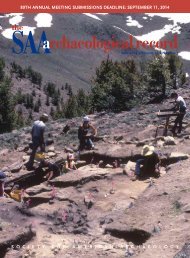SAA
SAA_Record_Nov2015
SAA_Record_Nov2015
You also want an ePaper? Increase the reach of your titles
YUMPU automatically turns print PDFs into web optimized ePapers that Google loves.
PROS AND CONS OF CONSULTING COLLECTORS<br />
land, Colorado, Don Wyckoff and I presented a paper on the<br />
discovery of an interesting cache recently found in McClain<br />
County, Oklahoma. I gave a Power Point presentation on Folsom<br />
Ultrathin Knives at the Oklahoma Anthropological Society<br />
spring meeting celebrating the fiftieth year of the society<br />
(see Cox and Westfall 2007 for a publication focused on the<br />
ultrathins). Finally, I was one of just a few individuals asked to<br />
display my Clovis and Folsom site materials at the Paleoamerican<br />
Odyssey in Santa Fe, New Mexico, in 2013.<br />
Another project I have worked on for many years is locating,<br />
photographing, and otherwise documenting collections<br />
from sites across Oklahoma and in other states. Many of<br />
these collections have since vanished, and my photographs<br />
and other documentation are all that survives. One such site<br />
is Cedar Creek, 34Wa-6, renowned for its Folsom and other<br />
Paleoindian deposits (Bell and Baerreis 1951; Cox 2007; and<br />
Hofman 1990). When some of the “old time” collections<br />
from this storied site, recovered in the 1920s through 1950s,<br />
became at risk of becoming lost and scattered, I either saw to<br />
it that they were donated to a public institution or I acquired<br />
many of the materials myself, preserving these important,<br />
non-reproducible, imperiled collections for future study and<br />
donation to the Sam Noble Museum of Natural History.<br />
As a final example of my work, I have long researched the<br />
whereabouts of the contents of the enigmatic Spiro Mound<br />
(e.g., Cox 2014a, b). Using old photographs and notes from<br />
Robert E. Bell and others, I have successfully located, recorded,<br />
and occasionally acquired many lost or unknown artifacts,<br />
photographs, and documents from this exceedingly<br />
important Caddoan mound site (Figure 2). The locality was<br />
looted by commercial diggers in the early 1930s and its fantastic,<br />
one-of-a-kind artifacts sold around the world. I have<br />
contacted many old-time collectors or their heirs from all<br />
over the country, especially in the Midwest, where many of<br />
the materials eventually came to reside. I have recorded their<br />
recollections, notes, and artifacts from this mound and the<br />
whereabouts of the artifacts today. I have shared my findings<br />
with professionals, most notably Dr. James Brown (retired)<br />
of Northwestern University, the preeminent Spiro scholar.<br />
Dr. Brown describes one old photograph that I obtained and<br />
curated as a “game changer” in his understanding of Spiro’s<br />
Hollow Central Chamber “Spirit Lodge” and the Great Mortuary.<br />
He will publish his new interpretations soon (Brown<br />
2014, personal communication).<br />
To close, I hope I have brought into focus some of the benefits<br />
as well as the sheer enjoyment of a harmonious collaboration<br />
between the professional archaeologist and the avocational<br />
collector. It seems a natural arrangement of common<br />
interests that I feel is a worthwhile pursuit that both groups<br />
should strive to achieve.<br />
Figure 2. Oklahoma State Archaeologist Robert Brooks admiring a 22-<br />
inch Spiro Craig Mound T-pipe, which the author researched, located,<br />
and acquired.<br />
References Cited<br />
Baker, William E., T.N. Campbell, and G.L. Evans<br />
1957 The Nall Site: Evidence of Early Man in the Oklahoma Panhandle.<br />
Bulletin of the Oklahoma Anthropological Society 5:1–20.<br />
Bell, Robert E., and David A. Baerreis<br />
1951 A Survey of Oklahoma Archaeology. Texas Archaeological<br />
and Paleontological Society Bulletin 22:7–100.<br />
Cox, Jim E.<br />
2007 The Cedar Creek Folsom Locality. Prehistoric American<br />
41(4):16–17.<br />
2014a A Spiro Copper Hand-and-Eye Motif and Its Interpretation.<br />
Central States Archaeological Journal 61(4):264–270.<br />
2014b The Williams Spiro Turtle Bowl. Central States Archaeological<br />
Journal 61(4):365–367.<br />
Cox, Jim E., and Tom Westfall<br />
2007 Folsom Ultrathin Knives: A Unique Tool in the Folsom<br />
Toolkit. Prehistoric American 41(4):54–56.<br />
Ford, James, and Clarence H. Webb<br />
1956 Poverty Point, a Late Archaic Site in Louisiana. Anthropological<br />
Papers of the American Museum of Natural History 1(1).<br />
Hofman, Jack L.<br />
1987 Ode to Collections Lost. Newsletter of the Oklahoma Anthropological<br />
Society 37(1):6–7.<br />
1990 A Folsom Locality in Southwestern Oklahoma. Current<br />
Research in the Pleistocene 7:19–23.<br />
Hofman, Jack L., G. Westfall, and T. Westfall<br />
2001 Westfall: A Folsom Campsite in the Black Forest Area of<br />
Colorado. Poster presented at the 59th Annual Plains Anthropological<br />
Conference, Lincoln, Nebraska.<br />
Holen, Steven<br />
2010 The Eckles Clovis Site, 14JW4, A Clovis Site in Northern<br />
Kansas. Plains Anthropologist 55:299–310.<br />
Rose, Richard O.<br />
2011 The Shifting Sands Site: A Southern Plains Folsom-Midland<br />
Assemblage. Bulletin of the Texas Archaeological Society<br />
82:299–324.<br />
Stafford, Michael D., George C. Frison, Dennis Stanford, and<br />
George Ziemans<br />
2003 Digging for the Color of Life: Paleoindian Red Ochre Mining<br />
at the Powars II Site, Platte County, Wyoming, USA. Geoarchaeology<br />
18(1):71–90.<br />
Yahnig, Carl<br />
2009 My One Hundred and One Favorite Artifacts from the Little River<br />
Clovis Complex. Hynek Printing, Richland Center, Wisconsin.<br />
November 2015 • The <strong>SAA</strong> Archaeological Record<br />
19




